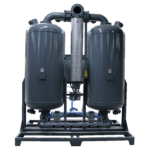Compressed air is essential in many industries—from manufacturing and automotive to food processing and pharmaceuticals. However, one challenge remains constant: moisture. When warm, humid air is compressed, water vapor condenses into liquid, which can damage equipment, contaminate products, and reduce efficiency.
This is where the refrigerated air dryer comes in.
In this article, we’ll explain how a refrigerated air dryer works, why it’s one of the most widely used air-drying technologies, and when it’s the right choice for your system.
What Is a Refrigerated Air Dryer?
A refrigerated air dryer is a device that removes moisture from compressed air by cooling the air to a low temperature, causing water vapor to condense into liquid. The condensed water is then drained out, leaving dry, clean compressed air behind.
This type of dryer is popular because it is:
Reliable
Easy to maintain
Energy-efficient
Suitable for most general industrial applications
How a Refrigerated Air Dryer Works
A refrigerated air dryer uses the same basic principles as a household refrigerator or air conditioner. The process typically includes four main stages:
1. Warm compressed air enters the dryer
After leaving the air compressor, the hot, moisture-laden compressed air enters the dryer. Because warm air holds more water vapor, the first step is to cool it down.
2. The air is cooled by a refrigeration system
Inside the dryer is a refrigeration circuit containing components such as:
Evaporator
Compressor
Condenser
Expansion valve
The evaporator cools the compressed air to around 3–10°C (37–50°F).
At this temperature, the water vapor in the air condenses into liquid droplets.
3. Moisture is removed through a separator and drain
Once condensed, the liquid water is extracted using a moisture separator.
Then, an automatic drain valve removes the accumulated water from the system, preventing it from re-entering the airstream.
4. The air is reheated before exiting
After moisture removal, the cold, dry air passes through a heat exchanger where it is reheated by incoming warm air.
This step improves energy efficiency and prevents condensation from forming on downstream pipes.
The result is clean, dry compressed air with a typical dew point of 2–10°C, which is sufficient for most industrial applications.
Types of Refrigerated Air Dryers
There are two main types:
1. Non-cycling refrigerated dryers
Run continuously
Simple and cost-effective
Best for steady air demand
2. Cycling refrigerated dryers
Adjust cooling based on airflow
More energy-efficient
Ideal for fluctuating demand
Come and choose your product

Advantages of Refrigerated Air Dryers
Affordable to operate
Low maintenance requirements
Stable dew point for general use
Long service life
They are an excellent choice for applications where ultra-dry air (e.g., −40°C dew point) is not required.
Common Applications
Refrigerated air dryers are widely used in:
Automotive workshops
Food and beverage plants
Packaging and printing
CNC machining
Textile manufacturing
Plastic molding
General factory air systems
Conclusion
Understanding how a refrigerated air dryer works helps you maintain a reliable and efficient compressed air system. By cooling the air and removing moisture, these dryers prevent corrosion, improve product quality, and extend equipment life—making them an essential part of industrial operations.






